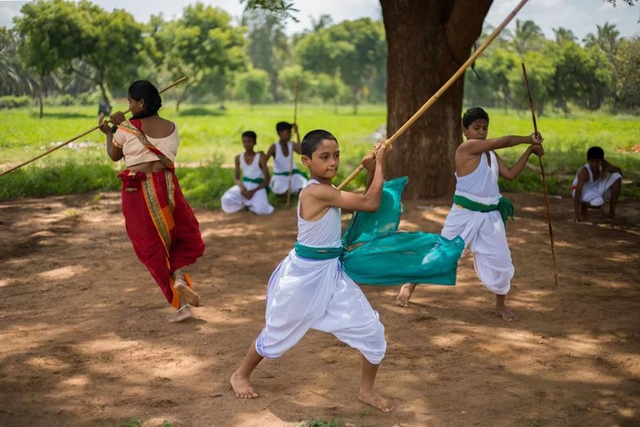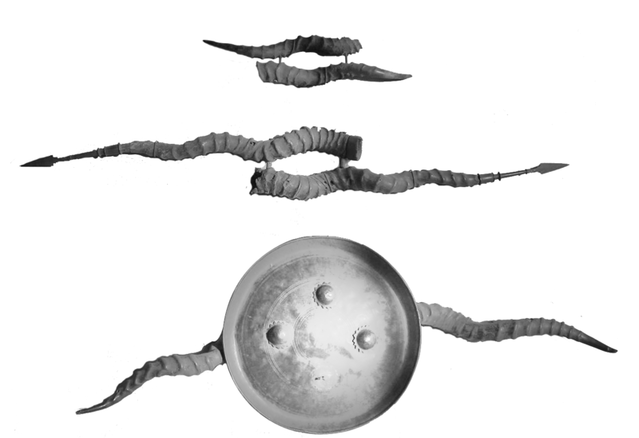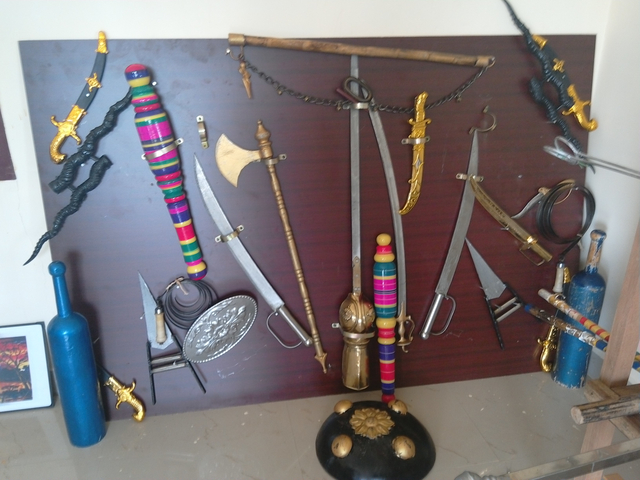
Silambam (Tamilnadu, India)
- Name of sport (game): Silmabam
- Place of practice (continent, state, nation):
India
- History:
Silambam is a weapon-based martial art of India, more specifically from Tamilakam (now Tamil Nadu region) in the Indian subcontinent, where it originated around 1000 BCE. This ancient fighting style is mentioned in Tamil Sangam literature 400 BCE.
Oral folklore traces Silambam back several thousand years to the siddhar (enlightened sage) Agastya. While on his way to Vellimalai, Agastya discussed Hindu philosophy with an old man he met, said to be the god Murugan in disguise. The old man taught him of kundalini yoga and how to focus prana through the body's nadi (channels). Agastya practiced this method of meditation and eventually compiled three texts on palm leaves based on the god's teachings. One of these texts was the Kampu Sutra (Staff Classic) which was said to record advanced fighting theories in verse. These poems and the art they described were allegedly passed on to other Siddha of the Agastmuni akhara (Agastya school) and eventually formed the basis of Silambam, siddha medicine, and the southern style of kalaripayat.References in the Silappadikkaram and other works of Sangam literature shows that silambam has been practiced as far back as the 4th century BC.The bamboo staff - along with swords, pearls and armor - was in great demand with foreign traders, particularly those from Southeast Asia where silambam greatly influenced many fighting systems. The Indian community of the Malay Peninsula is known to have practiced silambam as far back as the period of Melaka's founding in the 15th century, and likely much earlier.
The soldiers of Kings Puli Thevar, Dheeran Chinnamalai had Silambam army named "thadii pattalam", Veerapandiya Kattabomman and Maruthu Pandiyar (1760–1799) relied mainly on their Silambam prowess in their warfare against the British Army. Indian martial arts suffered a decline after the British colonists banned Silambam along with various other systems. They also introduced modern western military training which favoured fire-arms over traditional weaponry. During this time, Silambam became more common in Southeast Asia than its native India where it was banned by the British rulers. The ban was lifted after India achieved independence. Today, Silambam is the most famous and widely practiced Indian martial art in Malaysia where demonstrations are held for cultural shows.
- Description:
Silambam's main focus is on the bamboo staff. The length of the staff depends on the height of the practitioner. Ideally, it should just touch the forehead about three fingers from the head, typically measuring around 1.68 metres (five and a half feet). Different lengths may be used depending on the situation. For instance, the sedikuchi or 3-foot stick can be easily concealed. Separate practice is needed for staffs of different lengths. Listed below are some of the weapons used in Silambam.
Silambam: staff, preferably made from bamboo, but sometimes also from teak or Indian rose chestnut wood. The staff is immersed in water and strengthened by beating it on the surface of still or running water. It is often tipped with metal rings to prevent the ends from being damaged.
Maru: a thrusting weapon made from deer horns
Aruval: sickle, often paired
Panthukol: staff with balls of fire or weighted chains on each end
Savuku: whip
Vaal: sword, generally curved
Kuttu katai: spiked knuckleduster
Katti: knife
Kattari: native push-dagger with a H-shaped handle. Some are capable of piercing armor. The blade may be straight or wavy.
Surul kaththi: flexible sword
Sedikuchi: cudgel or short stick, often wielded as a pair.

The first stages of Silambam practice are meant to provide a foundation for fighting and to condition the body for the training itself. This includes improving flexibility, agility, hand-eye coordination, kinesthetic awareness, balance, strength, speed, muscular endurance, and cardiovascular stamina.
Beginners are first taught footwork (kaaladi) which they must master before learning spinning techniques and patterns, and methods to change the spins without stopping the motion of the stick. There are sixteen of them among which four are very important. Footwork patterns are the key aspects of Silambam. Traditionally, the masters first teach kaaladi for a long time before proceeding to unarmed combat. Training empty-handed allows the practitioner to get a feel of Silambam stick movements using their bare hands, that is, fighters have a preliminary training with bare hands before going to the stick.
Gradually, fighters study footwork to move precisely in conjunction with the stick movements. In Silambam, kaaladi is the key to deriving power for attacks. It teaches how to advance and retreat, to get within range of the opponent without lowering one's defence, aids in hitting and blocking, and it strengthens the body immensely enabling the fighter to receive non-lethal blows and still continue the battle. The whole body is used to create power.
In the main stance, the staff is held at one end, right hand close to the back, left hand about 40 centimetres (16 inches) away. This position allows a wide array of stick and body movements, including complex attacks and blocks. When the student reaches the final stage, the staff gets sharpened at one end. In real combat the tips may be poisoned. The ultimate goal of the training is to defend against multiple armed opponents.
Silambam prefers the hammer grip with the main hand facing down behind the weak hand which faces up. The strong hand grips the stick about a distance hand's width and thumb's length from the end of the stick and the weak hand is a thumb's length away from the strong hand. The weak hand only touches the stick and to guide its movement. Silambam stresses ambidexterity and besides the preferred hammer grip there are other ways of gripping the staff. Because of the way the stick is held and its relatively thin diameter, blows to the groin are very frequent and difficult to block. Besides the hammer grip, Silambam uses the poker grip and ice pick grip as well. Some blocks and hits are performed using the poker grip. The ice pick grip is used in single hand attacks. The staff is held like a walking stick and just hand gets inverted using the wrist.
Kattari
In battle, a fighter holds the stick in front of their body stretching the arms three-quarters full. From there, they can initiate all attacks with only a movement of the wrist. In fact, most Silambam moves are derived from wrist movement, making it a key component of the art. The blow gets speed from the wrist and power from the body through kaaladi. Since the stick is held in front, strikes are telegraphic, that is, the fighter does not hide their intentions from the opponent. They attack with sheer speed, overwhelming the adversary with a continuous non-stop rain of blows. In Silambam, one blow leads to and aids another. Bluffs may also be used by disguising one attack as another.In addition to the strikes, Silambam also has a variety of locks called poottu. A fighter must always be careful while wielding the stick or they will be grappled and lose the fight. Locks can be used to disable the enemy or simply capture their weapon. Techniques called thirappu are used to counter the locks but these must be executed before being caught in a lock. Silambam also has many different types of avoiding an attack like blocking, parrying, enduring, rotary parrying, hammering, kolluvuthal (attacking and blocking simultaneously) and evasive moves such as sitting or kneeling, moving out, jumping high, etc. Against multiple attackers, silambam exponents do not hold out their sticks as they do in single combat. Instead, they assume one of the numerous animal stances which makes it difficult for opponents to predict the next attack.
An expert of Silambam will be familiar with varma adi or marma adi (pressure points) and know where to strike anywhere in the body to produce fatal or crippling effects by the least use of power. In one-on-one combat an expert would slide the stick to opponents wrist many times during combat. The opponent may not notice this in the heat of battle until they feel a sudden pain in the wrist and throw the stick automatically without knowing what hit them. When two experts match against each other one may challenge the other that he will hit his big toe. Hitting the big toe can produce crippling effects on the fighter, making them abandon the fight. This is called solli adithal which means "challenging and successfully hitting".
Traditional masters still encourage students to live a "pure" life through daily meditation and abstaining from drinking, smoking, and meat consumption. Students who have completed the training syllabus by learning every form are considered qualified to teach. The time it takes to complete differs from one style to another. For example, the nillaikalakki style requires around seven years of training while other styles may have no articulated syllabus.
- Current status:
Practiced
- Sources of information :
Raj, J. David Manuel, The Origin and the Historical Developlment of Silambam Fencing: An Ancient Self-Defence Sport of India. Oregon: College of Health, Physical Education and Recreation, Univ. of Oregon, 1977
Balambal, V., Studies in the History of the Sangam Age. New Delhi: Kalinga Publications, 1998
Sports Authority of India, Indigenous Games and Martial Arts of India. New Delhi: Sports Authority of India, 1987
Robert Crego, Sports and Games of the 18th and 19th Centuries,. Greenwood Press, 2003 - Gallery:

